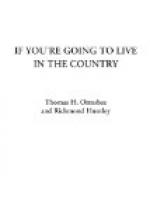But back to the little gray parsonage; its location and the fact that train service in its vicinity was poor, were the two deciding votes against it. Another attractive house in a good location was ruled out because our car got stuck in a spring hole practically in sight of it. A mile or so of dirt road to the station is no drawback, provided it is passable at all times of the year. This one was obviously poor, even in summer. Finally a real estate broker showed us a picture of a modest 18th century farm cottage. We visited the place one dreary sunless day in late March, investigated the neighborhood, determined the time required to drive to the nearest railroad station, and bought it, all in one week.
In general, we are not sure that such haste is advisable. There were certain disadvantages that we did not observe; there were others where we turned a blind eye because we were infatuated with the place and determined to have it. Fortunately time has taken care of practically all of these. In short, we have come to believe that a place in the country is, like marriage, just what you make it. In both cases, though, one’s emotions should be under control, so here are a few salient points for the searcher after a suitable location.
First and foremost, decide on the sort of life you wish to lead. Then pick your location to fit it. If you are not chained to a city desk five days a week but at best make only one or two weekly trips there, a railroad journey of two or three hours is endurable especially when a highly attractive place lies at the end. For such a person, the radius in which to look for likely places is much extended and the farther out, the more advantageous the prices. But for one individual so fortunately situated, there are more than a hundred who must choose a place near enough for daily trips to the city.
For the latter the ideal situation is, as stated before, an hour from house to office. That is the ideal but, in all honesty, we must admit that few attain it. The average country commuter is a born optimist on this point and will unblushingly distort facts in a manner to put the most ardent fisherman to shame. But figures don’t lie. If the time table, say between Stamford, Connecticut, and the Grand Central, New York, gives its fastest running time as fifty minutes, it means exactly that. You may plan to hurtle through the air at sixty miles an hour to the station but traffic and road conditions will not always let you. Besides, what is the hurry? Allow twenty or thirty minutes instead of fifteen for a normal run of twelve miles and have peace of mind. That gives you an hour and ten or fifteen minutes between your house and the city. Add the time needed to get from the train to your office and you know what is before you. We mention this station trip of twelve miles as about the maximum for the hardy commuter although there are a few who take more punishment than that. Of course if the perfect place can be found only four to six miles from the station that is all the better.




